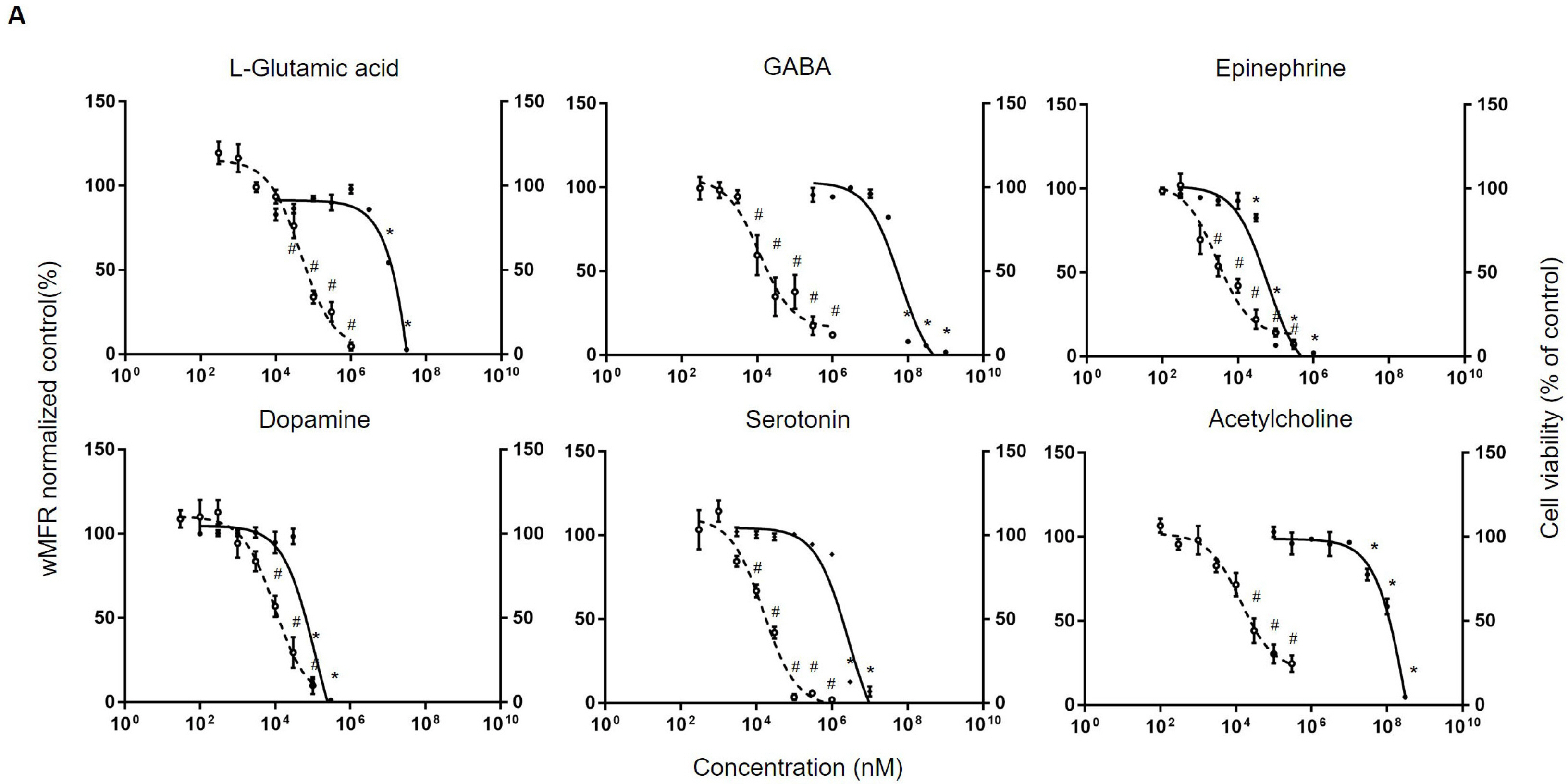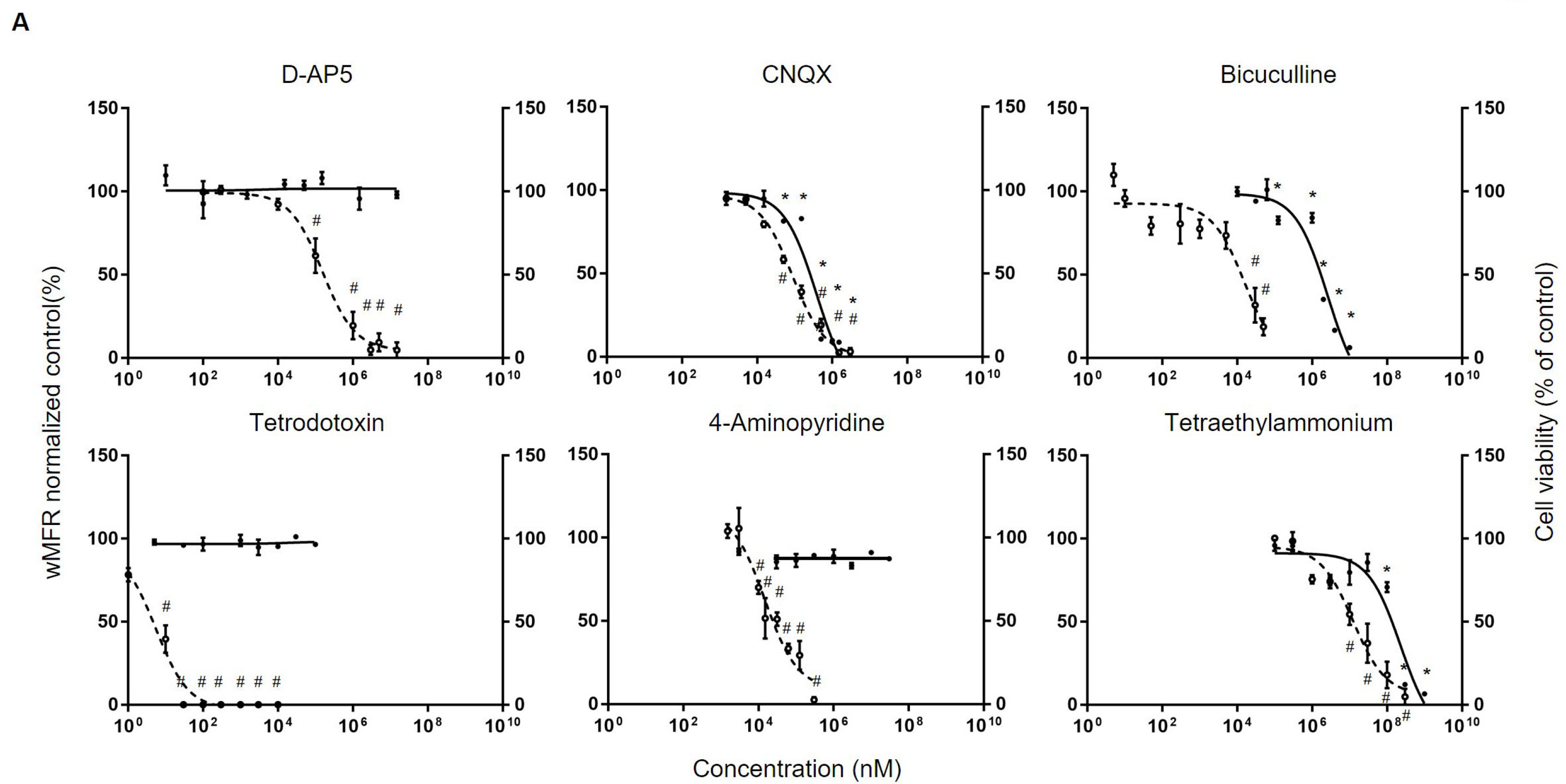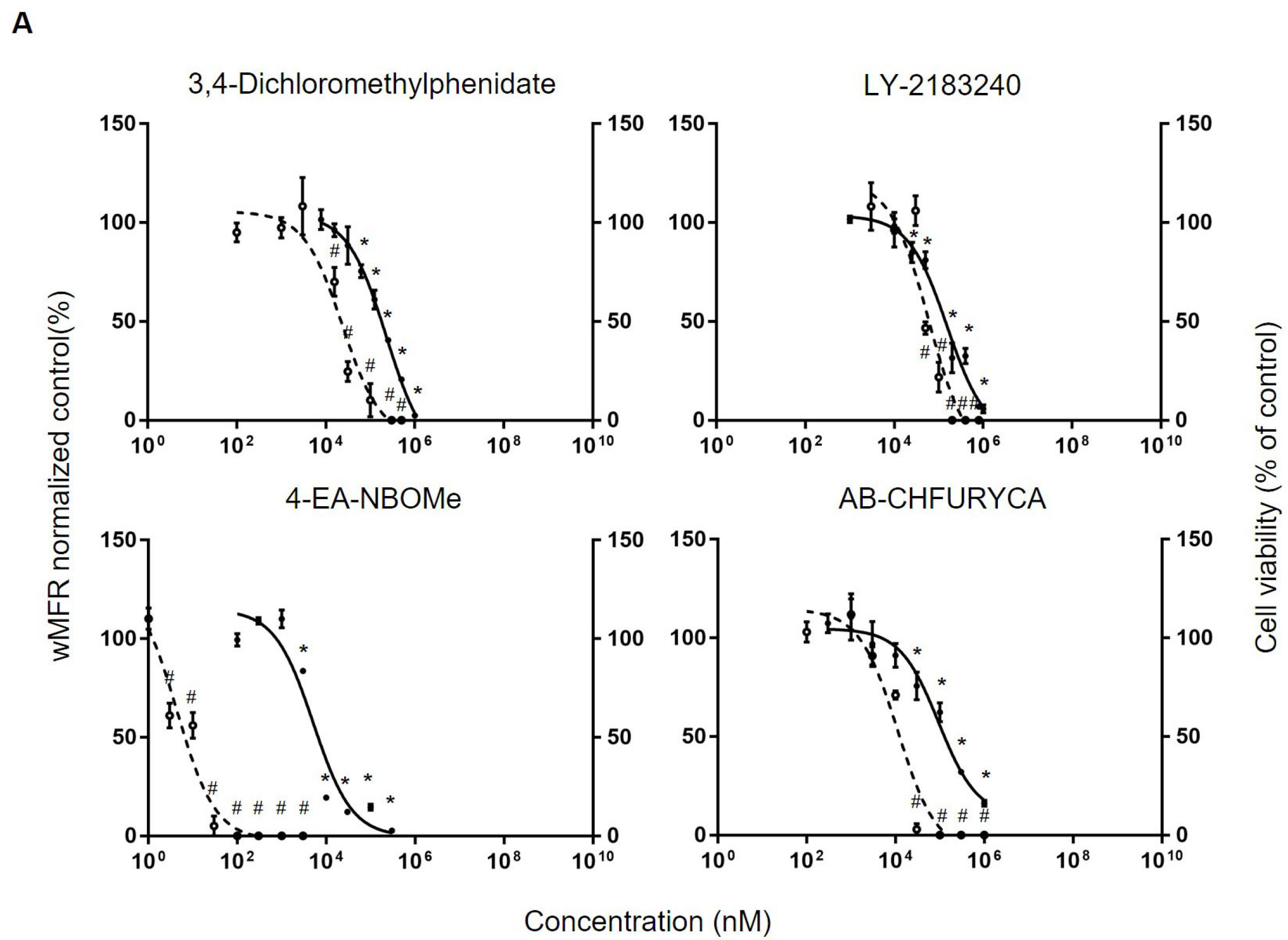Int J Stem Cells.
2022 Aug;15(3):258-269. 10.15283/ijsc21217.
Establishment of Neurotoxicity Assessment Using Microelectrode Array (MEA) with hiPSC-Derived Neurons and Evaluation of New Psychoactive Substances (NPS)
- Affiliations
-
- 1Department of Stem Cell Biology, School of Medicine, Konkuk University, Seoul, Korea
- 2Department of Physiology, College of Veterinary Medicine, Konkuk University, Seoul, Korea
- 3Department of Laboratory Animal Medicine, College of Veterinary Medicine, Seoul National University, Seoul, Korea
- 4Drug Abuse Research Group, Research Center of Convergence Toxicology, Korea Institute of Toxicology, Daejeon, Korea
- 5Pharmacological Research Division, Toxicological Evaluation and Research Department, National Institute of Food and Drug Safety Evaluation, Ministry of Food and Drug Safety, Cheongju, Korea
- 6Departments of Thoracis and Cardiovascular Surgery, Yonsei University Wonju College of Medicine, Wonju, Korea
- KMID: 2532400
- DOI: http://doi.org/10.15283/ijsc21217
Abstract
- Background and Objectives
Currently, safety pharmacological tests for the central nervous system depend on animal behavioral analysis. However, due to the subjectivity of behavioral analysis and differences between species, there is a limit to appropriate nervous system toxicity assessment, therefore a new neurotoxicity assessment that can simulate the human central nervous system is required.
Methods and Results
In our study, we developed an in vitro neurotoxicity assessment focusing on neuronal function. To minimize the differences between species and fast screening, hiPSC-derived neurons and a microelectrode array (MEA) that could simultaneously measure the action potentials of the neuronal networks were used. After analyzing the molecular and electrophysiological characters of our neuronal network, we conducted a neurotoxicity assessment on neurotransmitters, neurotoxicants, illicit drugs, and new psychoactive substances (NPS). We found that most substances used in our experiments responded more sensitively to our MEA-based neurotoxicity assessment than to the conventional neurotoxicity assessment. Also, this is the first paper that evaluates various illicit drugs and NPS using MEA-based neurotoxicity assessment using hiPSC-derived neurons.
Conclusions
Our study expanded the scope of application of neurotoxicity assessment using hiPSC-derived neurons to NPS, and accumulated evaluation data of various toxic substances for hiPSC-derived neurons.
Keyword
Figure
Reference
-
References
1. Bal-Price A, Hogberg HT, Crofton KM, Daneshian M, FitzGerald RE, Fritsche E, Heinonen T, Hougaard Bennekou S, Klima S, Piersma AH, Sachana M, Shafer TJ, Terron A, Monnet-Tschudi F, Viviani B, Waldmann T, Westerink RHS, Wilks MF, Witters H, Zurich MG, Leist M. 2018; Recommendation on test readiness criteria for new approach methods in toxicology: exemplified for developmental neurotoxicity. ALTEX. 35:306–352. Erratum in: ALTEX 2019;36:506. DOI: 10.14573/altex.1904112. PMID: 31329255. PMID: https://www.scopus.com/inward/record.uri?partnerID=HzOxMe3b&scp=85070184812&origin=inward.2. Grandjean P, Landrigan PJ. 2006; Developmental neurotoxicity of industrial chemicals. Lancet. 368:2167–2178. DOI: 10.1016/S0140-6736(06)69665-7. PMID: 17174709. PMID: https://www.scopus.com/inward/record.uri?partnerID=HzOxMe3b&scp=33845424655&origin=inward.3. Scialla M. 2016. Jun. 22. It Could Take Centuries for EPA to Test All the Unregulated Chemicals Under a New Landmark Bill [Internet]. PBS News Hour;Arlington: Available from: https://www.pbs.org/newshour/science/it-could-take-centuries-for-epa-to-test-all-the-unregulated-chemicals-under-a-new-landmark-bill. cited 2021 Nov 1.4. Bal-Price A, Hogberg HT, Crofton KM, Daneshian M, FitzGerald RE, Fritsche E, Heinonen T, Hougaard Bennekou S, Klima S, Piersma AH, Sachana M, Shafer TJ, Terron A, Monnet-Tschudi F, Viviani B, Waldmann T, Westerink RHS, Wilks MF, Witters H, Zurich MG, Leist M. 2019; Corrigendum to recommendation on test readiness criteria for new approach methods in toxicology: exemplified for developmental neurotoxicity. ALTEX. 36:506. Erratum for: ALTEX 2018;35:306-352. DOI: 10.14573/altex.1904112. PMID: 31329255. PMID: https://www.scopus.com/inward/record.uri?partnerID=HzOxMe3b&scp=85070184812&origin=inward.5. Tong ZB, Hogberg H, Kuo D, Sakamuru S, Xia M, Smirnova L, Hartung T, Gerhold D. 2017; Characterization of three human cell line models for high-throughput neuronal cytotoxicity screening. J Appl Toxicol. 37:167–180. DOI: 10.1002/jat.3334. PMID: 27143523. PMCID: PMC5094908. PMID: https://www.scopus.com/inward/record.uri?partnerID=HzOxMe3b&scp=84965130907&origin=inward.6. Leist M, Jäättelä M. 2001; Four deaths and a funeral: from caspases to alternative mechanisms. Nat Rev Mol Cell Biol. 2:589–598. DOI: 10.1038/35085008. PMID: 11483992. PMID: https://www.scopus.com/inward/record.uri?partnerID=HzOxMe3b&scp=0035433420&origin=inward.7. Pak YL, Swamy KM, Yoon J. 2015; Recent progress in fluorescent imaging probes. Sensors (Basel). 15:24374–24396. DOI: 10.3390/s150924374. PMID: 26402684. PMCID: PMC4610470. PMID: https://www.scopus.com/inward/record.uri?partnerID=HzOxMe3b&scp=84942134014&origin=inward.8. Castoldi AF, Coccini T, Ceccatelli S, Manzo L. 2001; Neuro-toxicity and molecular effects of methylmercury. Brain Res Bull. 55:197–203. DOI: 10.1016/S0361-9230(01)00458-0. PMID: 11470315. PMID: https://www.scopus.com/inward/record.uri?partnerID=HzOxMe3b&scp=0035872456&origin=inward.9. Sills RC, Valentine WM, Moser V, Graham DG, Morgan DL. 2000; Characterization of carbon disulfide neurotoxicity in C57BL6 mice: behavioral, morphologic, and molecular effects. Toxicol Pathol. 28:142–148. DOI: 10.1177/019262330002800118. PMID: 10669001. PMID: https://www.scopus.com/inward/record.uri?partnerID=HzOxMe3b&scp=0033973711&origin=inward.10. Kiernan MC, Isbister GK, Lin CS, Burke D, Bostock H. 2005; Acute tetrodotoxin-induced neurotoxicity after ingestion of puffer fish. Ann Neurol. 57:339–348. DOI: 10.1002/ana.20395. PMID: 15732107. PMID: https://www.scopus.com/inward/record.uri?partnerID=HzOxMe3b&scp=14844318086&origin=inward.11. Hondebrink L, Verboven AHA, Drega WS, Schmeink S, de Groot MWGDM, van Kleef RGDM, Wijnolts FMJ, de Groot A, Meulenbelt J, Westerink RHS. 2016; Neurotoxicity screening of (illicit) drugs using novel methods for analysis of microelectrode array (MEA) recordings. Neurotoxicology. 55:1–9. DOI: 10.1016/j.neuro.2016.04.020. PMID: 27149913. PMID: https://www.scopus.com/inward/record.uri?partnerID=HzOxMe3b&scp=84965075992&origin=inward.12. Wing C, Komatsu M, Delaney SM, Krause M, Wheeler HE, Dolan ME. 2017; Application of stem cell derived neuronal cells to evaluate neurotoxic chemotherapy. Stem Cell Res. 22:79–88. DOI: 10.1016/j.scr.2017.06.006. PMID: 28645005. PMCID: PMC5737666. PMID: https://www.scopus.com/inward/record.uri?partnerID=HzOxMe3b&scp=85021095824&origin=inward.13. Zwartsen A, Hondebrink L, Westerink RH. 2018; Neurotoxicity screening of new psychoactive substances (NPS): effects on neuronal activity in rat cortical cultures using microelectrode arrays (MEA). Neurotoxicology. 66:87–97. DOI: 10.1016/j.neuro.2018.03.007. PMID: 29572046. PMID: https://www.scopus.com/inward/record.uri?partnerID=HzOxMe3b&scp=85044757012&origin=inward.14. Vassallo A, Chiappalone M, De Camargos Lopes R, Scelfo B, Novellino A, Defranchi E, Palosaari T, Weisschu T, Ramirez T, Martinoia S, Johnstone AFM, Mack CM, Landsiedel R, Whelan M, Bal-Price A, Shafer TJ. 2017; A multi-laboratory evaluation of microelectrode array-based measurements of neural network activity for acute neurotoxicity testing. Neurotoxicology. 60:280–292. DOI: 10.1016/j.neuro.2016.03.019. PMID: 27036093. PMID: https://www.scopus.com/inward/record.uri?partnerID=HzOxMe3b&scp=84962407428&origin=inward.15. Tukker AM, Wijnolts FMJ, de Groot A, Westerink RHS. 2018; Human iPSC-derived neuronal models for in vitro neurotoxicity assessment. Neurotoxicology. 67:215–225. DOI: 10.1016/j.neuro.2018.06.007. PMID: 29909083. PMID: https://www.scopus.com/inward/record.uri?partnerID=HzOxMe3b&scp=85048729038&origin=inward.16. Park JH, Kim J, Walter J, Kim CY. 2022; Use of neural 3D organoid with MEA in neurotoxicity testing: comparison to traditional in vitro cell culture and in vivo methods. Mol Cell Toxicol. 18:17–21. DOI: 10.1007/s13273-021-00184-z. PMID: https://www.scopus.com/inward/record.uri?partnerID=HzOxMe3b&scp=85117847297&origin=inward.17. Suresh J, Radojicic M, Pesce LL, Bhansali A, Wang J, Tryba AK, Marks JD, van Drongelen W. 2016; Network burst activity in hippocampal neuronal cultures: the role of synaptic and intrinsic currents. J Neurophysiol. 115:3073–3089. DOI: 10.1152/jn.00995.2015. PMID: 26984425. PMCID: PMC4946605. PMID: https://www.scopus.com/inward/record.uri?partnerID=HzOxMe3b&scp=84984804885&origin=inward.18. Garcia VJ, Rushton DJ, Tom CM, Allen ND, Kemp PJ, Svendsen CN, Mattis VB. 2019; Huntington's disease patient-derived astrocytes display electrophysiological impairments and reduced neuronal support. Front Neurosci. 13:669. DOI: 10.3389/fnins.2019.00669. PMID: 31316341. PMCID: PMC6610155. PMID: https://www.scopus.com/inward/record.uri?partnerID=HzOxMe3b&scp=85068475175&origin=inward.19. Mikami Y, Yamazawa T. 2015; Chlorogenic acid, a polyphenol in coffee, protects neurons against glutamate neurotoxicity. Life Sci. 139:69–74. DOI: 10.1016/j.lfs.2015.08.005. PMID: 26285175. PMID: https://www.scopus.com/inward/record.uri?partnerID=HzOxMe3b&scp=84940048353&origin=inward.20. Ruehle S, Remmers F, Romo-Parra H, Massa F, Wickert M, Wörtge S, Häring M, Kaiser N, Marsicano G, Pape HC, Lutz B. 2013; Cannabinoid CB1 receptor in dorsal telencephalic glutamatergic neurons: distinctive sufficiency for hippocampus-dependent and amygdala-dependent synaptic and behavioral functions. J Neurosci. 33:10264–10277. DOI: 10.1523/JNEUROSCI.4171-12.2013. PMID: 23785142. PMCID: PMC6618598. PMID: https://www.scopus.com/inward/record.uri?partnerID=HzOxMe3b&scp=84879135358&origin=inward.21. Campbell SL, Hablitz JJ, Olsen ML. 2014; Functional changes in glutamate transporters and astrocyte biophysical properties in a rodent model of focal cortical dysplasia. Front Cell Neurosci. 8:425. DOI: 10.3389/fncel.2014.00425. PMID: 25565960. PMCID: PMC4269128. PMID: https://www.scopus.com/inward/record.uri?partnerID=HzOxMe3b&scp=84919433348&origin=inward.22. Camp AJ, Lim R, Anderson WB, Schofield PR, Callister RJ, Brichta AM. 2010; Attenuated glycine receptor function reduces excitability of mouse medial vestibular nucleus neurons. Neuroscience. 170:348–360. DOI: 10.1016/j.neuroscience.2010.06.040. PMID: 20600650. PMID: https://www.scopus.com/inward/record.uri?partnerID=HzOxMe3b&scp=77955920870&origin=inward.23. Hanganu IL, Kilb W, Luhmann HJ. 2001; Spontaneous synaptic activity of subplate neurons in neonatal rat somatosensory cortex. Cereb Cortex. 11:400–410. DOI: 10.1093/cercor/11.5.400. PMID: 11313292. PMID: https://www.scopus.com/inward/record.uri?partnerID=HzOxMe3b&scp=0035011515&origin=inward.24. Naujock M, Stanslowsky N, Bufler S, Naumann M, Reinhardt P, Sterneckert J, Kefalakes E, Kassebaum C, Bursch F, Lojewski X, Storch A, Frickenhaus M, Boeckers TM, Putz S, Demestre M, Liebau S, Klingenstein M, Ludolph AC, Dengler R, Kim KS, Hermann A, Wegner F, Petri S. 2016; 4-aminopyridine induced activity rescues hypoexcitable motor neurons from amyotrophic lateral sclerosis patient-derived induced pluripotent stem cells. Stem Cells. 34:1563–1575. DOI: 10.1002/stem.2354. PMID: 26946488. PMID: https://www.scopus.com/inward/record.uri?partnerID=HzOxMe3b&scp=84973109229&origin=inward.25. Stotz SC, Scott LO, Drummond-Main C, Avchalumov Y, Girotto F, Davidsen J, Gómez-Gárcia MR, Rho JM, Pavlov EV, Colicos MA. 2014; Inorganic polyphosphate regulates neuronal excitability through modulation of voltage-gated channels. Mol Brain. 7:42. DOI: 10.1186/1756-6606-7-42. PMID: 24886461. PMCID: PMC4061113. PMID: https://www.scopus.com/inward/record.uri?partnerID=HzOxMe3b&scp=84902833632&origin=inward.26. Gilbert GL, Kim HJ, Waataja JJ, Thayer SA. 2007; Delta9-tetrahydrocannabinol protects hippocampal neurons from excitotoxicity. Brain Res. 1128:61–69. DOI: 10.1016/j.brainres.2006.03.011. PMID: 17140550. PMID: https://www.scopus.com/inward/record.uri?partnerID=HzOxMe3b&scp=33846066404&origin=inward.27. Poon HF, Abdullah L, Mullan MA, Mullan MJ, Crawford FC. 2007; Cocaine-induced oxidative stress precedes cell death in human neuronal progenitor cells. Neurochem Int. 50:69–73. DOI: 10.1016/j.neuint.2006.06.012. PMID: 16956698. PMID: https://www.scopus.com/inward/record.uri?partnerID=HzOxMe3b&scp=33845307204&origin=inward.28. Reynolds JL, Mahajan SD, Aalinkeel R, Nair B, Sykes DE, Schwartz SA. 2009; Proteomic analyses of the effects of drugs of abuse on monocyte-derived mature dendritic cells. Immunol Invest. 38:526–550. DOI: 10.1080/08820130902874110. PMID: 19811410. PMCID: PMC2812871. PMID: https://www.scopus.com/inward/record.uri?partnerID=HzOxMe3b&scp=70350580814&origin=inward.29. Longworth M, Banister SD, Mack JBC, Glass M, Connor M, Kassiou M. 2016; The 2-alkyl-2H-indazole regioisomers of synthetic cannabinoids AB-CHMINACA, AB-FUBINACA, AB-PINACA, and 5F-AB-PINACA are possible manufacturing impurities with cannabimimetic activities. Forensic Toxicol. 34:286–303. DOI: 10.1007/s11419-016-0316-y. PMID: 27547266. PMCID: PMC4971050. PMID: https://www.scopus.com/inward/record.uri?partnerID=HzOxMe3b&scp=84964462208&origin=inward.30. Zhang X, Feng ZJ, Chergui K. 2015; Induction of cannabinoid- and N-methyl-D-aspartate receptor-mediated long-term depression in the nucleus accumbens and dorsolateral striatum is region and age dependent. Int J Neuropsychophar-macol. 18:pyu052. DOI: 10.1093/ijnp/pyu052. PMID: 25618403. PMCID: PMC4360221. PMID: https://www.scopus.com/inward/record.uri?partnerID=HzOxMe3b&scp=84939143482&origin=inward.31. Luethi D, Kaeser PJ, Brandt SD, Krähenbühl S, Hoener MC, Liechti ME. 2018; Pharmacological profile of methylphenidate-based designer drugs. Neuropharmacology. 134(Pt A):133–140. DOI: 10.1016/j.neuropharm.2017.08.020. PMID: 28823611. PMID: https://www.scopus.com/inward/record.uri?partnerID=HzOxMe3b&scp=85030175626&origin=inward.32. Caspar AT, Meyer MR, Maurer HH. 2018; Human cytochrome P450 kinetic studies on six N-2-methoxybenzyl (NBOMe)-derived new psychoactive substances using the substrate depletion approach. Toxicol Lett. 285:1–8. DOI: 10.1016/j.toxlet.2017.12.017. PMID: 29277574. PMID: https://www.scopus.com/inward/record.uri?partnerID=HzOxMe3b&scp=85039740351&origin=inward.33. Tukker AM, Van Kleef RGDM, Wijnolts FMJ, De Groot A, Westerink RHS. 2020; Towards animal-free neurotoxicity screening: applicability of hiPSC-derived neuronal models for in vitro seizure liability assessment. ALTEX. 37:121–135. DOI: 10.14573/altex.1907121. PMID: 31686111. PMID: https://www.scopus.com/inward/record.uri?partnerID=HzOxMe3b&scp=85078387567&origin=inward.34. Zwartsen A, Hondebrink L, de Lange DW, Westerink RHS. 2020; Hyperthermia exacerbates the acute effects of psychoactive substances on neuronal activity measured using microelectrode arrays (MEAs) in rat primary cortical cultures in vitro. Toxicol Appl Pharmacol. 397:115015. DOI: 10.1016/j.taap.2020.115015. PMID: 32320794. PMID: https://www.scopus.com/inward/record.uri?partnerID=HzOxMe3b&scp=85084368996&origin=inward.35. Baskar MK, Murthy PB. 2018; Acute in vitro neurotoxicity of some pyrethroids using microelectrode arrays. Toxicol In Vitro. 47:165–177. DOI: 10.1016/j.tiv.2017.11.010. PMID: 29207333. PMID: https://www.scopus.com/inward/record.uri?partnerID=HzOxMe3b&scp=85036506013&origin=inward.36. Odawara A, Saitoh Y, Alhebshi AH, Gotoh M, Suzuki I. 2014; Long-term electrophysiological activity and pharmacological response of a human induced pluripotent stem cell-derived neuron and astrocyte co-culture. Biochem Biophys Res Commun. 443:1176–1181. DOI: 10.1016/j.bbrc.2013.12.142. PMID: 24406164. PMID: https://www.scopus.com/inward/record.uri?partnerID=HzOxMe3b&scp=84893772545&origin=inward.37. Hondebrink L, Kasteel EEJ, Tukker AM, Wijnolts FMJ, Verboven AHA, Westerink RHS. 2017; Neuropharmacological characterization of the new psychoactive substance metho-xetamine. Neuropharmacology. 123:1–9. DOI: 10.1016/j.neuropharm.2017.04.035. PMID: 28454981. PMID: https://www.scopus.com/inward/record.uri?partnerID=HzOxMe3b&scp=85019605466&origin=inward.38. Odawara A, Matsuda N, Ishibashi Y, Yokoi R, Suzuki I. 2018; Toxicological evaluation of convulsant and anticonvulsant drugs in human induced pluripotent stem cell-derived cortical neuronal networks using an MEA system. Sci Rep. 8:10416. DOI: 10.1038/s41598-018-28835-7. PMID: 29991696. PMCID: PMC6039442. PMID: https://www.scopus.com/inward/record.uri?partnerID=HzOxMe3b&scp=85049841001&origin=inward.39. Lu C, Shi X, Allen A, Baez-Nieto D, Nikish A, Sanjana NE, Pan JQ. 2019; Overexpression of NEUROG2 and NEUROG1 in human embryonic stem cells produces a network of excitatory and inhibitory neurons. FASEB J. 33:5287–5299. DOI: 10.1096/fj.201801110RR. PMID: 30698461. PMCID: PMC6436650. PMID: https://www.scopus.com/inward/record.uri?partnerID=HzOxMe3b&scp=85064107656&origin=inward.40. Bright S. 2013. New and emerging drugs. Australian Drug Foundation;Melbourne: PMID: https://www.scopus.com/inward/record.uri?partnerID=HzOxMe3b&scp=0035872456&origin=inward.41. Peacock A, Bruno R, Gisev N, Degenhardt L, Hall W, Sedefov R, White J, Thomas KV, Farrell M, Griffiths P. 2019; New psychoactive substances: challenges for drug surveillance, control, and public health responses. Lancet. 394:1668–1684. DOI: 10.1016/S0140-6736(19)32231-7. PMID: 31668410. PMID: https://www.scopus.com/inward/record.uri?partnerID=HzOxMe3b&scp=85073696629&origin=inward.
- Full Text Links
- Actions
-
Cited
- CITED
-
- Close
- Share
- Similar articles
-
- Effect of Xenogeneic Substances on the Glycan Profiles and Electrophysiological Properties of Human Induced Pluripotent Stem Cell-Derived Cardiomyocytes
- Erectile Dysfunction Associated with Psychoactive Substances
- Evaluation of Nurse Practitioners' Professional Competence and Comparison of Assessments Using Multiple Methods: Self-Assessment, Peer Assessment, and Supervisor Assessment
- Analysis of Electrically Evoked Potential in Rabbits with Polyimide Retinal Stimulator
- Effect of Oxygen Radicals on Cultured Cerebral Neurons of Neonatal Mouse





